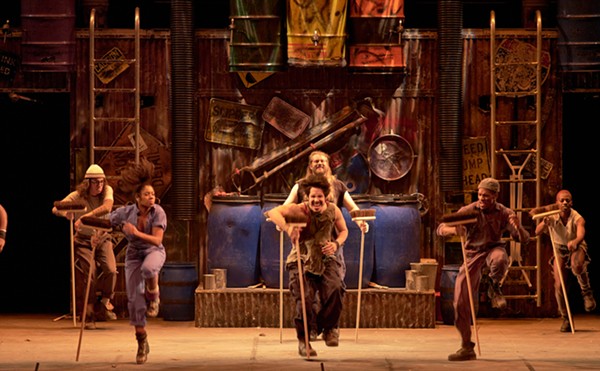Local Artists Deconstruct Text Messages in Thought-Provoking Exhibition at the Yards Project
What are we really communicating?
By Shawn Mishak on Fri, Sep 2, 2022 at 9:55 am
[
{
"name": "Ad - NativeInline - Injected",
"component": "38482495",
"insertPoint": "3",
"requiredCountToDisplay": "5"
},{
"name": "Real 1 Player (r2) - Inline",
"component": "38482494",
"insertPoint": "2/3",
"requiredCountToDisplay": "9"
}
]
Local artists pull at the thread of texts as communication and art and see what unravels in 'Text Messages,' a new exhibition that opened yesterday at the Yards Project.
Texting allows us to bail on plans at a moment’s notice, connect in a moment, contour perceptions to fit our sense of self, and converse in ways both chess and checkers.
The participating artists here — Karl Anderson, Shadi Ayoub, Malcolm Barrett, Anna Chapman, Ron Copeland, Jeffry Chiplis, Paula Damm, Michael Gannon, Erin Guido, Brittany M. Hudak, Bob Kelemen, Micah Kraus, Melinda Placko, Sampson the Artist, and Rachel Yurkovich — deconstruct the almighty text through a variety of different mediums and genres including illustration-neon, light installation, embroidery, assemblages, painting, and photography.
“There are so many different kinds of media used, text that is coded and encrypted, weavings with text, reclaimed signage, neon, painting, letterpress, weaving, collaging all using text in various ways so there is really something for everyone,” said Liz Maugans, who put together the show.
While texting keeps us connected it can also displace and substitute for forms of in-person communication, which leaves us wondering what it means to be present with someone.
Under this line of thinking, people can feel “so close yet so far away,” and words can be misleading without the person’s tone and inflection there to help give context to our conversations. Think of how many times you have misread a text message or an email in your work or professional lives.
“I use text in a lot in my own work and so this is a show that I have wanted to do for a long time at Yards Projects, you know, steal some of the artists' recipes,” said Maugans. “Words are used as concrete material, like paint or charcoal, but also utilized as companions to images."
This exhibition begs to ask how we value personal interaction and how being always available can drain us. As social creatures, the text message, while suiting a host of practical applications, can detract from opportunities to learn and communicate based on facial patterns and body language.
One piece in the show is simply words on a brown piece of paper reading:
“Meaning making.
Life: shove cellphones in her
Human face.
Starving to death on a full stomach.”
This last line is reminiscent of the quote, “Water, water everywhere but nor a drop to drink” from Samuel Taylor Coleridge's work “The Rime of the Ancient Mariner,” and it is used to imply that in spite of being surrounded by something, you may not be able to take advantage of it. It's also indicative of addiction where the need is seemingly endless while the supply never suffices.
Have things becomes too convenient, too addictive? Are we communication gluttons but connection-starved?
“Rachel Yurkovich’s collages where words are cut from magazines and newspapers deals a lot her disconnect from video/digital technologies during the shutdown,” said Maugans. "Creating the word collages were something simply she could do to tell her story with as few words as possible. The blank space and omissions become collaborative with the person reading it. She talks about the obsession people have with their phones, computers, earphones and the disconnect those bring to our lives.”
In the piece “Hell is Real” by Micah Kraus, the artist seems to reference the religious fire and brimstone pamphlets one might get handed to them on a street corner.
In one configuration, the text uses words and phrases like eternity is scary, Heaven, doubt, and real. The words are scattered and there are spaces left blank because as the viewer pulls a chord new phrasing is emphasized or created.
“Micah uses words that through the interaction of pulling a cord, a new variation is highlighted, and in this case reads that says, Is HELL REAL?” said Maugans. “Vinyl wall text sits aside the IS HELL REAL powder-coated steel and another sign is manipulated to fill in the blanks of the wall vinyl. My thoughts are that at any given time we may not be certain of the dystopian times we are living in, is it hell or can we talk ourselves out of thinking that. Text is malleable, not quite fact or fiction. Micah is a great word play artists.”
The show runs through Oct. 22. An open house will be hosted Sept. 17 from 10 a.m. to 2 p.m.
SCENE Supporters make it possible to tell the Cleveland stories you won’t find elsewhere.
Become a supporter today.
Scroll to read more Arts Stories & Interviews articles
Newsletters
Join Cleveland Scene Newsletters
Subscribe now to get the latest news delivered right to your inbox.












